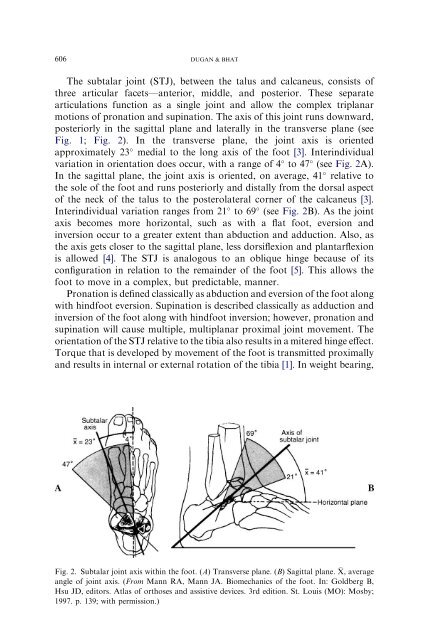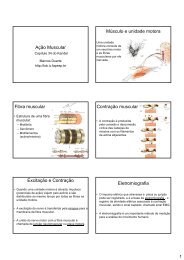Biomechanics and Analysis of Running Gait - De Motu
Biomechanics and Analysis of Running Gait - De Motu
Biomechanics and Analysis of Running Gait - De Motu
Create successful ePaper yourself
Turn your PDF publications into a flip-book with our unique Google optimized e-Paper software.
606 DUGAN & BHAT<br />
The subtalar joint (STJ), between the talus <strong>and</strong> calcaneus, consists <strong>of</strong><br />
three articular facets—anterior, middle, <strong>and</strong> posterior. These separate<br />
articulations function as a single joint <strong>and</strong> allow the complex triplanar<br />
motions <strong>of</strong> pronation <strong>and</strong> supination. The axis <strong>of</strong> this joint runs downward,<br />
posteriorly in the sagittal plane <strong>and</strong> laterally in the transverse plane (see<br />
Fig. 1; Fig. 2). In the transverse plane, the joint axis is oriented<br />
approximately 23 medial to the long axis <strong>of</strong> the foot [3]. Interindividual<br />
variation in orientation does occur, with a range <strong>of</strong> 4 to 47 (see Fig. 2A).<br />
In the sagittal plane, the joint axis is oriented, on average, 41 relative to<br />
the sole <strong>of</strong> the foot <strong>and</strong> runs posteriorly <strong>and</strong> distally from the dorsal aspect<br />
<strong>of</strong> the neck <strong>of</strong> the talus to the posterolateral corner <strong>of</strong> the calcaneus [3].<br />
Interindividual variation ranges from 21 to 69 (see Fig. 2B). As the joint<br />
axis becomes more horizontal, such as with a flat foot, eversion <strong>and</strong><br />
inversion occur to a greater extent than abduction <strong>and</strong> adduction. Also, as<br />
the axis gets closer to the sagittal plane, less dorsiflexion <strong>and</strong> plantarflexion<br />
is allowed [4]. The STJ is analogous to an oblique hinge because <strong>of</strong> its<br />
configuration in relation to the remainder <strong>of</strong> the foot [5]. This allows the<br />
foot to move in a complex, but predictable, manner.<br />
Pronation is defined classically as abduction <strong>and</strong> eversion <strong>of</strong> the foot along<br />
with hindfoot eversion. Supination is described classically as adduction <strong>and</strong><br />
inversion <strong>of</strong> the foot along with hindfoot inversion; however, pronation <strong>and</strong><br />
supination will cause multiple, multiplanar proximal joint movement. The<br />
orientation <strong>of</strong> the STJ relative to the tibia also results in a mitered hinge effect.<br />
Torque that is developed by movement <strong>of</strong> the foot is transmitted proximally<br />
<strong>and</strong> results in internal or external rotation <strong>of</strong> the tibia [1]. In weight bearing,<br />
Fig. 2. Subtalar joint axis within the foot. (A) Transverse plane. (B) Sagittal plane. X, average<br />
angle <strong>of</strong> joint axis. (From Mann RA, Mann JA. <strong>Biomechanics</strong> <strong>of</strong> the foot. In: Goldberg B,<br />
Hsu JD, editors. Atlas <strong>of</strong> orthoses <strong>and</strong> assistive devices. 3rd edition. St. Louis (MO): Mosby;<br />
1997. p. 139; with permission.)



